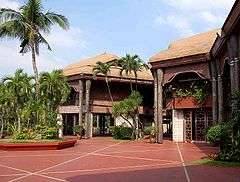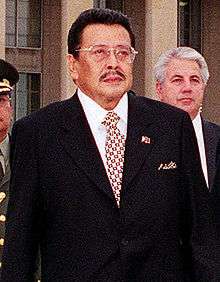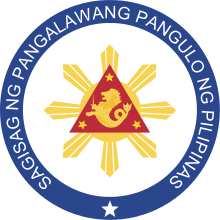Vice President of the Philippines
| Vice President of the Philippines Pangalawang Pangulo ng Pilipinas | |
|---|---|
|
| |
|
| |
| Style | Madam Vice President (Informal) |
| Residence | Quezon City Reception House |
| Seat | Quezon City, Philippines |
| Term length | Six years |
| Constituting instrument | 1987 Constitution of the Philippines |
| Inaugural holder | Sergio Osmeña |
| Formation | November 15, 1935 |
| Succession | First in the Presidential Line of Succession |
| Salary | ₱353,482 per month/ ₱4,241,640 per year |
| Website |
www |
 |
| This article is part of a series on the politics and government of the Philippines |
|
Legislature
|
|
Constitutional Commissions |
The Vice President of the Philippines (Filipino: Pangalawang Pangulo ng Pilipinas) is the second-highest executive official of the government of the Philippines, after the President. The Vice President currently holds office at the Quezon City Reception House in Quezon City. Previously, the Vice President of the Philippines held office at the Coconut Palace (located in the Cultural Center of the Philippines Complex), the Philippine National Bank Financial Center, and the Philippine International Convention Center (also located in the CCP Complex), all in Pasay, Metro Manila.
Bearing similarities with the office as created in the 1935 Constitution before that Constitution was abolished by the Marcos regime, the current office of the Vice President was re-established under the 1987 Constitution.
Title
The official title of the office in Filipino is Pangalawang Pangulo, although Bise Presidente, derived from Spanish, is the usual title used in some of the major Philippine languages, such as Cebuano.
The text of the 1987 Constitution refers to the person and office of the Vice-President, with a dash connecting the two words. However, the person and office is usually referred to today without the dash, as the Vice President.
History
Colonial era
The first known vice president claiming to be part of a government was Mariano Trías, whose term started on March 22, 1897. He was elected during the elections of the Tejeros Convention, and was later elected vice president of the Supreme Council that oversaw negotiations for the Biak na Bato pact in 1897. This Supreme Council had no sovereignty, did not govern any state, and was just used for bargaining with the Spanish. This council was replaced later, with no such position existing during the country's declaration of independence in 1898, which had a dictatorial government. Officially, the country's first actual republic was founded in 1899, and it too had no vice president. Trias instead served in the cabinets of Apolinario Mabini and Pedro Paterno, as finance minister and war minister, respectively. Trias is not considered a Philippine Vice President as the Supreme Council did not proclaim any sovereign state.
Conceptualization
The 1935 Constitution of the Philippines established the position of Vice President, and may be appointed by the President to a cabinet position. The first person elected to the position of Vice President under the constitution was Sergio Osmeña. Elected together with Manuel L. Quezon in the first Philippine national elections, Osmena was given the highest-ranking cabinet portfolio with inauguration of the Commonwealth of the Philippines in November 1935. Prior to independence in 1946, that cabinet portfolio was Secretary of Public Instruction, which had once been reserved only for the Vice Governor-General (an American). Vice President Osmena held that position from 1935–1939, and a similar portfolio in the War Cabinet during World War II.
After independence, the highest-ranking cabinet position became that of Secretary of Foreign Affairs (it is still the highest-ranking cabinet portfolio in official protocol to this day), which was given to Vice President Elpidio Quirino. Vice President Fernando Lopez declined the Foreign Affairs portfolio when he became Quirino's Vice President in 1949. However, Vice Presidents Carlos P. Garcia and Emmanuel Pelaez also held the Foreign Affairs portfolio, a tradition revived in the Fifth Republic, with Vice Presidents Salvador Laurel and Teofisto Guingona, Jr. holding the Foreign Affairs portfolio. Gloria Macapagal-Arroyo served as Secretary of Social Welfare and Development. Other Cabinet positions with no Secretary title was given to Joseph Estrada as Chairman of the Presidential Anti-Crime Commission and Noli de Castro as Chairman of the Housing and Urban Development Coordinating Council.
Among the Vice Presidents of the Third Republic, Diosdado Macapagal alone was not given any cabinet position, since he was the first elected Vice-President that did not originate from the same party as the incumbent. Arturo Tolentino was officially proclaimed Vice President-elect by the Regular Batasang Pambansa in 1986. He took his oath as Vice President on February 16, 1986 before Chief Justice Ramon Aquino but because of popular belief that the elections had been rigged, he never actually served out his term as Vice President. Within a week after Tolentino's oath, the People Power Revolution resulted in the collapse of the Marcos regime. On February 25, 1986 Corazon Aquino and Salvador H. Laurel were sworn in as President and Vice President.[1]
Fourth Republic
The office of Vice President was abolished and not included in the original version of the 1973 Constitution. It was, however, reinstated in subsequent amendments, just before the snap elections in 1986 that led to the People Power Revolution that installed Corazon Aquino into the Presidency.
Timeline

Eligibility
Article 7, Section 3 of the Constitution mandates that the Vice President must bear the same qualifications as the President which means he must be:
- a natural-born citizen of the Philippines;
- a registered voter;
- able to read and write;
- at least forty years of age on the day of election;
- and a resident of the Philippines for at least ten years immediately preceding such election."[2]
Election and term limits
The Vice President is elected in the same manner as, but separately from, the President.[3] Both the President and the Vice President are elected by direct plurality vote where the candidate who garners the highest number of votes, whether a majority or not, wins the election.[4] While candidates usually run in tandem for the offices of President and Vice President, under their own political parties, it is possible and not unusual for candidates from different parties to be elected as President and Vice President.
The Vice President is barred from serving more than two consecutive terms.[4]
Succession
The Vice President is first in the presidential line of succession. The Constitution provides several circumstances where the Vice President (or the Vice President-elect) shall assume the Presidency or serve as acting President.
- In case of the death, permanent disability, removal from office, or resignation of the President, the Vice President shall assume the Presidency.[5]
- If the President-elect fails to qualify for office, the Vice President-elect shall act as president until the President-elect is qualified.[6]
- If a President is not chosen, then Vice President shall act as President until a President is chosen and qualified.[6]
There has been four cases where the Vice President has assumed the Presidency, three of which because of the President's death, and one because of the President's resignation:
- Sergio Osmeña in 1944, upon the death of Manuel L. Quezon.
- Elpidio Quirino in 1948, upon the death of Manuel Roxas.
- Carlos P. Garcia in 1957, upon the death of Ramon Magsaysay.
- Gloria Macapagal-Arroyo in 2001, upon the resignation of Joseph Ejercito Estrada, as decided by the Supreme Court.[7]
Salary
The Vice President is paid ₱353,476 (approximately US$7,080) per month and ₱ 4,241,640 per annum as of July 1 2016 by virtue of Executive Order No. 201 series of 2016 as authorized by Congressional Joint Resolution No. 4 series.[8] Prior to the raise, the monthly salary was around ₱100,000.[9][10]
The salary of the Vice President is determined by Congress and the pay cannot be reduced during his tenure. Any increase approved during his tenure can only take effect after such tenure.
Seat

Historically, the Vice President was not given an official residence. However, the Vice President also held office along with the President at the Executive Building (now Kalayaan Hall) in the complex of Malacañang Palace from 1935 until 1972, when the position was abolished under martial law and the 1973 Constitution. When the position was reinstated, Vice President Salvador H. Laurel held office at the former Legislative Building at Padre Burgos Avenue, Manila, until the building became the National Museum of the Philippines. The Vice President's office was transferred to the Philippine International Convention Center, and again to the PNB Financial Center, both in Pasay, Metro Manila in 2005.[12] In 2011, the Coconut Palace also in Pasay was designated as the principal workplace of the Vice President of the Philippines. Beginning June 30, 2016, the office was transferred to the Quezon City Reception House in Quezon City.
Land transport
The Vice President of the Philippines generally rides in a Mercedes Benz W140 S-Class, backed up by personnel from the Presidential Security Group.
Living former Vice Presidents
-

Joseph Estrada
(under Fidel V. Ramos)
Born April 19, 1937 -

Gloria Macapagal Arroyo
(under Joseph Estrada)
Born April 5, 1947 -

Teofisto Guingona
(under Gloria Macapagal-Arroyo)
Born July 4, 1928 -

Noli de Castro
(under Gloria Macapagal-Arroyo)
Born July 6, 1949 -

Jejomar Binay
(under Benigno Aquino III)
Born November 11, 1942
See also
- List of current Vice Presidents
- List of Presidents of the Philippines
- List of Vice Presidents of the Philippines
- President of the Philippines
- Prime Minister of the Philippines (defunct)
- Seal of the Vice President of the Philippines
- First Spouse of the Philippines
References
| Wikisource has original text related to this article: |
- ↑ The Vice Presidency : A Brief History, Office of the Vice President of the Philippines.
- ↑ 1987 Constitution of the Philippines, art. 7, sec. 2
- ↑ 1987 Constitution of the Philippines, art. 7, sec. 3.
- 1 2 1987 Constitution of the Philippines, art. 7, sec. 4.
- ↑ 1987 Constitution of the Philippines, art. 7, sec. 8.
- 1 2 1987 Constitution of the Philippines, art. 7, sec. 7.
- ↑ "Philippine Supreme Court Decision. G.R. Nos. 146710-15. March 2, 2001.". Supreme Court of the Philippines.
- ↑ 1987 Constitution of the Philippines, art. 7, sec. 6
- ↑ http://www.dbm.gov.ph/wp-content/uploads/2012/03/Manual-on-PCC-Chapter-5.pdf
- ↑ http://www.gov.ph/downloads/2012/04apr/20120430-EO-0076-BSA.pdf
- ↑ ABS-CBN Corp. "Binay set for Coconut Palace move".
- ↑ "For trivia-hunters, Benigno S. Aquino III and the presidency (updated)".
External links
| Wikimedia Commons has media related to Vice presidents of the Philippines. |


